A Mysterious and Romantic Island in the Middle of the Ocean
2021/08/18
Easter Island

An island isolated in the South Pacific, Rapa Nui or Easter Island is one of the most popular ports of call during Peace Boat voyages, and the giant Moai statues that stand around the island are a particular highlight of the trip. Easter Island is very isolated and difficult to access from anywhere else in the world, with only a few ways to reach there. That’s why the island, dotted with stone statues still shrouded in mystery, attracts people from all over the world. This distance, the encounter with the Moai statues, sightseeing on the island, and interacting with the people responsible for preserving the beautiful natural environment here for the future are just some of the many attractions that make this island so enticing.
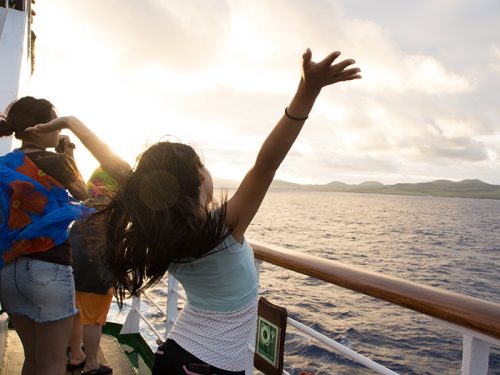
How to Reach the Isolated Easter Island
Geographically, Easter Island is the most isolated place in the world, surrounded by ocean for a radius of about 2,000 kilometers. There are two ways to get there by air: via Santiago, the capital of Chile, or via Tahiti. Both are quite long flights, making it one of the most inaccessible tourist destinations on the planet. Also, when visiting the island on a Peace Boat voyage, it takes slightly less than a week from the South American ports of Valparaiso in Chile or Callao in Peru, and eight days from Tahiti. Because it is so difficult to get to, it is very moving when you finally arrive.
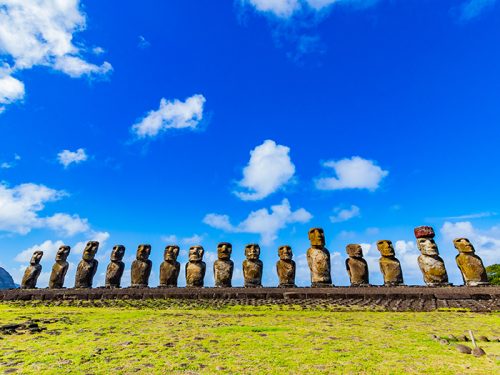
Visit the Island Protected by Moais
There is no harbor for large cruise ships to dock on Easter Island, so the ships anchor offshore and passengers use tender boats. The fresh breeze caressing your cheeks and the occasional splash of the waves as you sail along is refreshing in itself. One of the landing points is the village of Hanga Roa, the base for Moai sightseeing. From here, you will visit Ahu Tongariki, where 15 Moai statues line up. In the past, all of the Moai standing on the altar called “Ahu” had fallen over due to the Moai-Toppling wars and the tsunami caused by the 1960 earthquake off the coast of Chile. It is well-known in Japan that a Japanese crane company supported the restoration and reconstruction of the fallen Moai. The 15 Moai statues, lined up majestically against the sea, are breathtakingly beautiful.
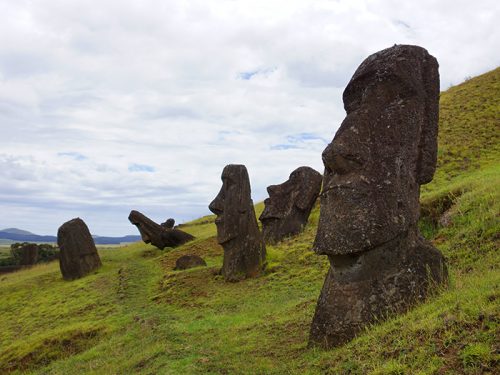
Rano Raraku is a rocky hill from where the majority of the Moai statues were carved, so it is also called the “Moai Manufacturing Factory.” Here, you can see a variety of unique Moai statues, including some buried up to the chest in soil and others still in the process of being carved out of the rock. It is said that it took 30 people more than a year to complete a single 10-meter high Moai. There are about 400 of these Moai statues left in this area. If you go around Rano Raraku, you will see the only seated Moai statue on the island, called “Moai Tukuturi”. Its kneeling form is something quite familiar to many.

Next, you will visit Anakena Beach, one of the few beaches on the island where you can swim. This beach is loved not only by tourists but also by the local islanders, and the contrast of blue and white is beautiful. At this spectacular spot you can gaze upon the pure white sand and the beautiful Moai statues, here called Ahu Naunau. Five of the seven statues are in perfect shape, with even the patterns carved on their backs clearly visible, and the “pukao,” said to be a hat or hair tied on top of the head, also beautifully preserved.
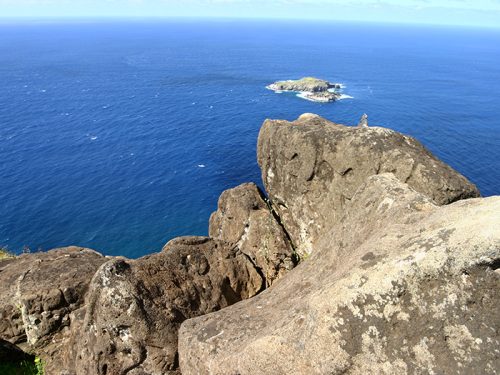
More Than Moais
There are many other things to see on Easter Island other than the Moai. Cape Orongo on the south side of the island is home to the legend of the bird man. In this legend, the first person to jump into the ocean from the tip of this cape and bring back a tern egg from Motu Nui Island off the coast will become the “bird man” (chief of the island) for the next year. It is said that many braves challenged this ritual in the 17th century. The ruins of houses from that time still remain around Cape Orongo, as well as rocks carved with the figures of bird people, reminding us of the lives and culture of the people of the past.
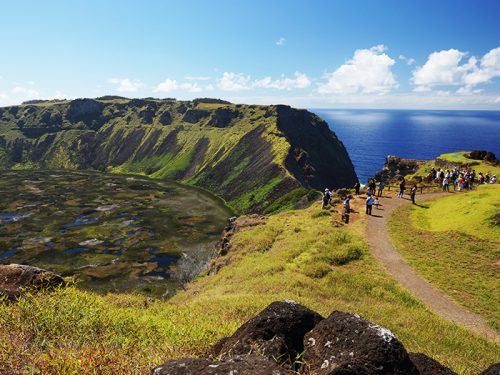
Stretching out right next to Cape Orongo is the crater of Rano Kau volcano. The crater of this volcano forms a vast caldera lake, also a precious water source for the island. The lake’s scenery, adorning the huge crater with a diameter of 1,600 meters, is simply breathtaking. The beauty of the uniquely colored ocean is another attraction of Easter Island. As a volcanic island formed by the eruption of magma from an underwater volcano, with only the tops of the volcanoes exposed to the ocean from the deep floor, the coastline of the island is either cliffs or rocks. Because of the sudden deepening of the water, the ocean around Easter Island has a unique turquoise color, darker than that of Tahiti and other places.
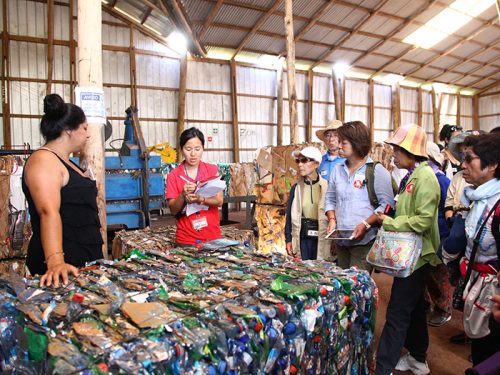
Meeting the Local Community
Easter Island is a popular tourist destination, but at the same time, the development of the tourism industry and the increase in population has caused a variety of environmental problems. On our Peace Boat voyages, during our port calls, we provide opportunities to learn about the current situation on the island from the local community and to work together to pick up trash and plant trees. Afterwards, we hold very popular cultural exchanges with local people, including the island’s traditional body painting, learning traditional dance, and using calligraphy goods to write the islanders’ names in Japanese or Chinese characters. The experience of spending time with the locals and experiencing the “now” of an isolated island in the middle of the ocean is a very special part of the trip.
PHOTO: PEACEBOAT, Katsuta Airi, Isogai Miki, Matsuda Sakika, Nakamura Mitsutoshi, Stacy Hughes
